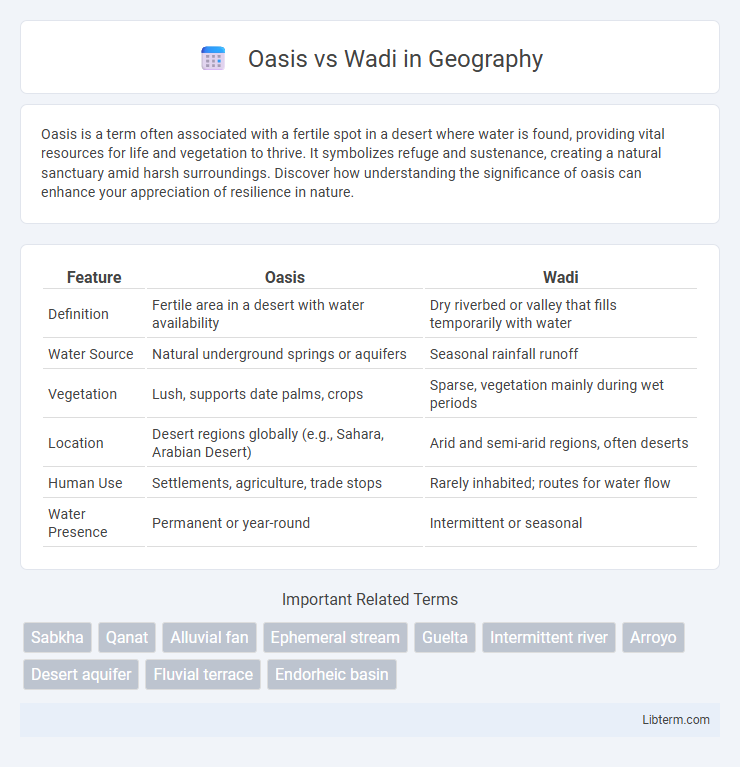Oasis is a term often associated with a fertile spot in a desert where water is found, providing vital resources for life and vegetation to thrive. It symbolizes refuge and sustenance, creating a natural sanctuary amid harsh surroundings. Discover how understanding the significance of oasis can enhance your appreciation of resilience in nature.
Table of Comparison
| Feature | Oasis | Wadi |
|---|---|---|
| Definition | Fertile area in a desert with water availability | Dry riverbed or valley that fills temporarily with water |
| Water Source | Natural underground springs or aquifers | Seasonal rainfall runoff |
| Vegetation | Lush, supports date palms, crops | Sparse, vegetation mainly during wet periods |
| Location | Desert regions globally (e.g., Sahara, Arabian Desert) | Arid and semi-arid regions, often deserts |
| Human Use | Settlements, agriculture, trade stops | Rarely inhabited; routes for water flow |
| Water Presence | Permanent or year-round | Intermittent or seasonal |
Introduction to Oasis and Wadi
An oasis is a fertile area in a desert where water is available, supporting vegetation and human settlement, often formed by underground springs or natural wells. A wadi is a dry riverbed or valley that temporarily fills with water during heavy rain but remains dry for most of the year. Both oases and wadis are critical for sustaining life and agriculture in arid environments.
Defining Oasis: Key Characteristics
An oasis is a fertile area in a desert where water is naturally available, supporting vegetation and human habitation. It typically features a reliable water source such as a spring or underground aquifer, enabling palm trees and crops to thrive amidst arid surroundings. Unlike a wadi, which is a dry riverbed that only carries water during seasonal rains, an oasis sustains life year-round due to its permanent water supply.
Understanding Wadi: Features and Formation
A wadi is a dry riverbed or valley that remains dry except during the rainy season when it carries water from heavy rainfall to lower areas, often transforming into a temporary stream or river. Formed by erosion over time, wadis feature steep banks and are common in arid and semi-arid regions, serving as crucial channels for water flow and sediment transport during flash floods. These geological formations contrast with oases, which are permanent water sources supporting vegetation and human settlements in deserts.
Geographic Distribution of Oases and Wadis
Oases are predominantly found in arid desert regions such as the Sahara in North Africa, the Arabian Peninsula, and parts of Central Asia where groundwater reaches the surface, creating fertile spots amid vast aridity. Wadis, by contrast, are dry riverbeds or valleys common in Middle Eastern deserts like those in Saudi Arabia, Yemen, and Oman, where water flows seasonally during rains. The geographic distribution of oases and wadis is closely tied to climatic patterns and underlying geology, influencing human settlement and agricultural practices in these harsh environments.
Ecological Importance: Oasis vs Wadi
Oases provide critical ecological refuges in arid deserts, supporting diverse flora and fauna by offering consistent water sources and fertile soil for vegetation growth. Wadis, typically dry riverbeds that occasionally flood, contribute to desert ecosystems by enabling nutrient-rich sediment deposition and temporary water availability, which sustains plant life and wildlife during rainy periods. Both ecosystems play vital roles in maintaining biodiversity and stabilizing desert environments, but oases offer more permanent habitats compared to the seasonal nature of wadis.
Water Sources and Availability
Oases are fertile areas in deserts with a reliable water source, typically from natural springs or underground rivers, supporting vegetation and human settlements. Wadis are dry riverbeds that only contain water intermittently after heavy rainfall, resulting in sporadic and unpredictable water availability. The key distinction lies in the permanence of water presence, with oases offering stable access while wadis rely on seasonal or occasional rainwater.
Human Settlements: Historical and Modern Perspectives
Oases have historically served as vital hubs for human settlements, offering permanent water sources in arid regions that enabled agriculture, trade, and cultural development. In contrast, wadis, characterized by intermittent water flow, typically supported seasonal or temporary settlements due to their unpredictable moisture availability. Modern urban expansion in oasis regions continues to rely on sustainable water management, while wadis often pose challenges for infrastructure development due to flash flooding risks and variable environmental conditions.
Agricultural Impact in Oases and Wadis
Oases support sustainable agriculture by providing reliable water sources in arid regions, enabling the cultivation of crops like date palms, vegetables, and grains through natural springs or man-made wells. Wadis, characterized by seasonal water flow, allow for temporary agricultural activities during and immediately after rains but often face soil erosion and nutrient depletion challenges. The stable water availability in oases fosters long-term agricultural productivity and human settlement, while wadis demand adaptive farming techniques to capitalize on sporadic water pulses.
Challenges and Environmental Threats
Oases face significant environmental threats such as water depletion, salinization, and desertification due to over-extraction of groundwater and climate change, which disrupt their fragile ecosystems. Wadis encounter challenges including flash flooding, erosion, and sedimentation that can alter their landscapes and impact surrounding habitats, often exacerbated by irregular rainfall patterns and human activities. Both environments are vulnerable to anthropogenic pressures like urbanization and agricultural expansion, threatening their sustainability and biodiversity.
Oasis vs Wadi: Key Differences and Final Comparison
Oasis and wadi represent distinct geographical features in arid regions, with an oasis being a fertile area containing water sources that support vegetation and life, while a wadi refers to a dry riverbed that typically fills with water only during rare rain events. Oases are permanent or semi-permanent habitats critical for agriculture and human settlement, whereas wadis serve as seasonal waterways that influence desert hydrology and erosion patterns. Understanding the key differences between oasis and wadi highlights their contrasting roles in desert ecosystems, with oases providing sustainable water resources and wadis acting as temporary channels shaped by episodic rainfall.
Oasis Infographic

 libterm.com
libterm.com